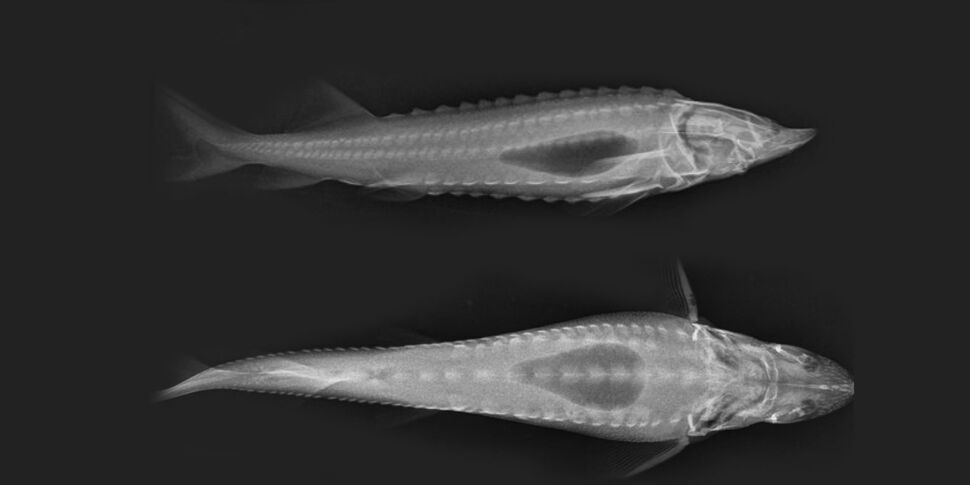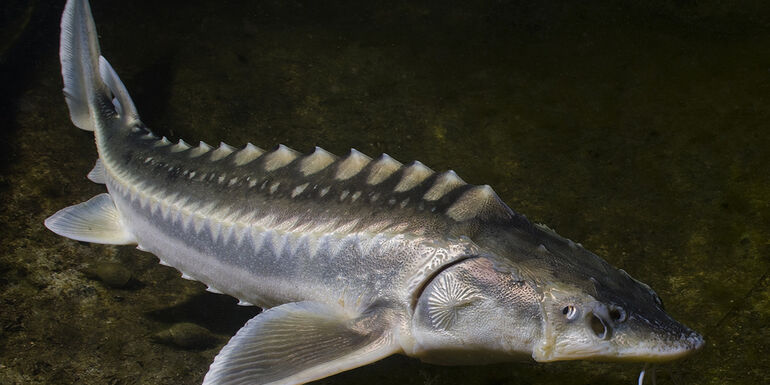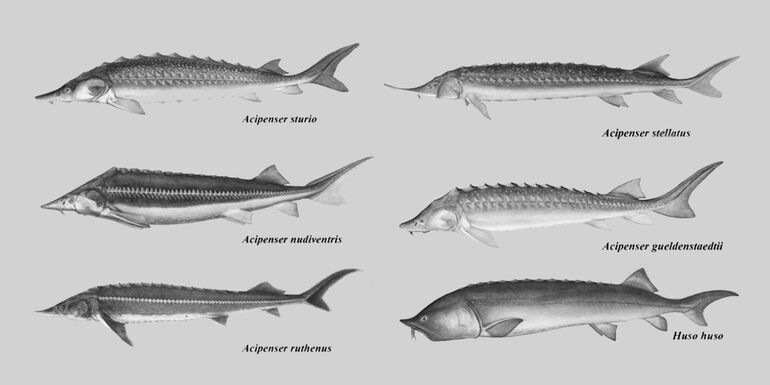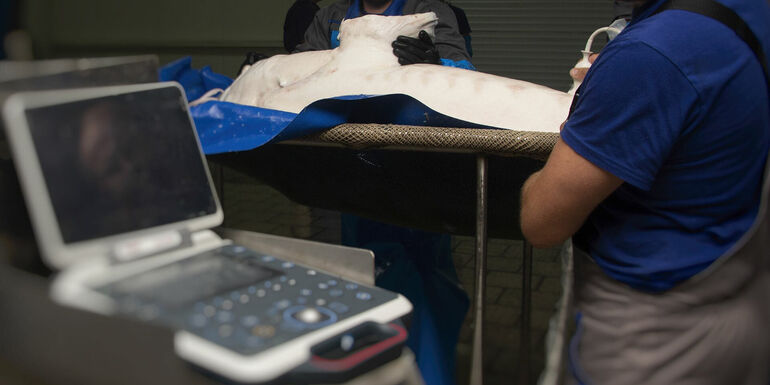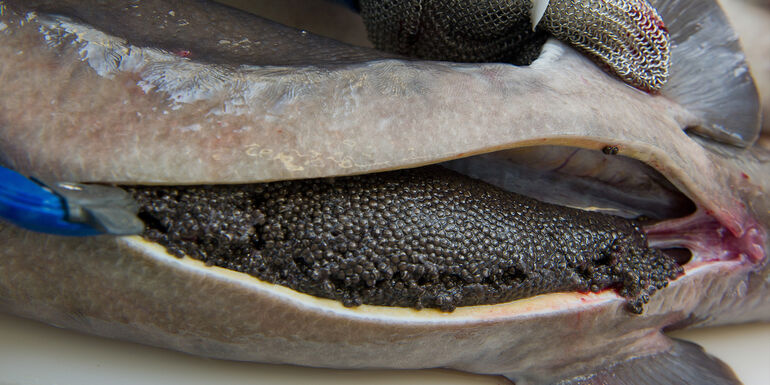
The story of caviar, one of the most exclusive delicacies in the world.
Sturgeon are long-lived and late-maturing fish that belong to the family of Acipenseridae, which is comprised of 27 species. The earliest fossils of sturgeons can be traced back to more than 200 million years ago. This fish belongs to a special group called Chondrostei that are characterised by the cartilaginous nature of their skeleton, with only a small degree of ossification (formation of bone). Instead of scales, they have skutes that form a strong exoskeleton.
Aquatir
One of the first farms to start farming different sturgeon species in a highly professional way is Aquatir in Moldova. The sturgeon are farmed in a state-of-the-art RAS farming enterprise that meets the highest quality standards. In these facilities, the water is filtered and reconditioned so that it can be reused many times. All of the important water parameters — like oxygen, water temperature, etc. — are strictly controlled and maintained at the optimal levels. As a result, external influences are completely excluded from the recirculating aquaculture system, and the fish live in optimal conditions and feel comfortable all the time. The well-being and health of the fish are crucial at Aquatir, as they form the basis of these high-quality, delicious products. Quality is their core value!
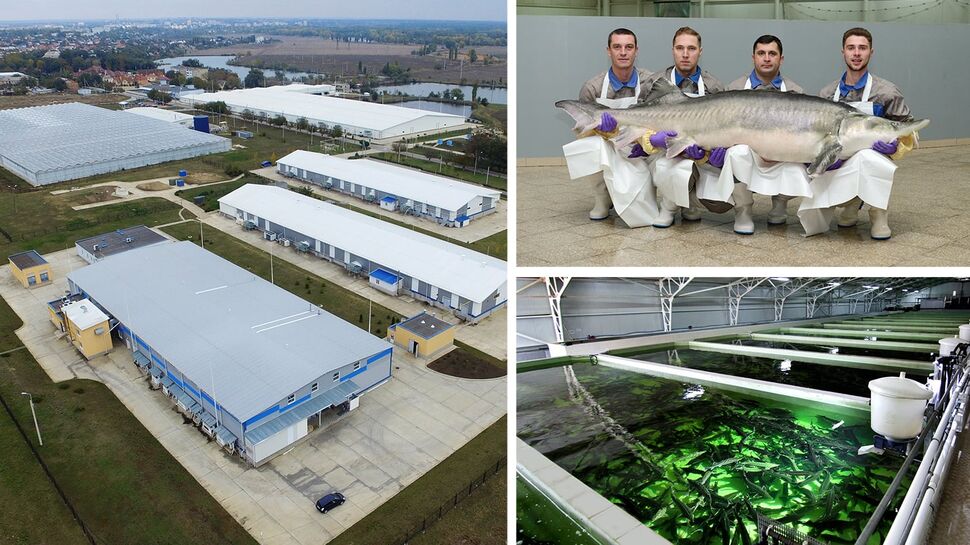
The sturgeon farm and processing at Aquatir are operated by highly qualified and experienced professionals. Over the years, Aquatir has expanded its operation, and the farm today consists of numerous units, including incubation, hatchery and fry, ongrowing, broodstock, pre-wintering and wintering, next to a laboratory and a large processing facility. Over the years, Aquatir has increased its product range and is renowned for its classically produced caviar, for which they only use salt, no artificial preservatives. With a salt percentage of 3–5%, the unique and natural taste of caviar remains unsullied. The caviar is packed under vacuum (to safeguard its aroma and taste) into tins, glass and crystal jars and cans of 10 to 1,000 grams, which suits Aqautir’s various caviar customers around the world. Veterinary, sanitary and laboratory controls are carried out on each batch to meet the highest food safety standards, and Aquatir also meets the FSSC 22000 standard.
Technology "from egg to egg"
An important advantage maintained by Aquatir is the complete technological cycle of fish breeding — from fish eggs to adult fish, which, in turn, produces eggs, starting the cycle over again. At Aquatir, the fry are divided into two groups: the first is raised to obtain caviar for sale and the second to replenish the broodstock. “Each individual sturgeon is raised with love and care in an ecologically clean facility under the constant supervision of our highly qualified specialists,” said Nikolay Diligur, chief fish breeder at Aquatir.
The fry grow in absolutely clean water from artesian wells that have undergone additional filtration. Additionally, the caviar processing methods allow for the preservation of the unique combination of taste and useful qualities inherent in caviar from wild fish. “You will be pleasantly surprised by the delicate taste of this classic product prepared in accordance with all the required food standards for caviar production of today,” said Diligur.
Sturgeon caviar has a wide range of colour shades, and as such, Aquatir never mixes caviar from different individual fish in the process of salting and packaging. “It is also important that, in addition to running the commercial activities, our company carries out work aimed at preserving viable fish stock for release into their natural habitat in order to restore the natural populations,” said Kasaeva Svetlana, deputy director for production and science.
As a result, together with the Institute of Zoology of the Republic of Moldova and under the supervision of international specialists CITES, Aquatir is stocking the Dniester River. “Today, more than 50,000 Russian sturgeon fry from our enterprise have already been released,” Svetlana said.
Depending on the sturgeon species, it can take a substantial number of years before the females are ready to produce caviar. For example, sterlet sturgeon may be ready to give caviar after 3 years, while Siberian sturgeon more often wait 5 to 6 years and Russian sturgeon for 7 to 8 years. The beluga has the longest cycle and largest caviar, so it takes around 10 to 12 years to harvest its caviar. This long maturation interval makes sturgeon extremely vulnerable in the wild.
In the RAS facility at Aquatir, where an optimal water temperature can be provided year-round, the sturgeon mature much quicker than they would in the wild. “The maturation cycle of the sturgeon in Aquatir’s farm can be reduced by about 25% compared to that in the wild,” said Kasaeva Svetlana, Aquatir’s deputy director for production and science. “This saves costs and helps to get a consistent high-quality caviar that is available any time of the year.”
Challenges
Sturgeon have a long maturation process and, therefore, require both a high initial investment and high operational costs. The proper design and management of the RAS facility, optimum RAS feed quality, proper feeding management and adequate health management are all essential for successful caviar production and to get the right caviar quality and quantity. Using first-class RAS feed with a proper feeding strategy is vital to achieve optimal performance in a sturgeon RAS farm.
Because sturgeon are kept on-farm for many years and grow quite old, it is even more important to supply specific sturgeon feeds with all of the important nutrients they need in ample amounts. By doing so, the aging females stay healthy and robust, even at an advanced age, and are able to continue providing delicious caviar.
All Alltech Coppens sturgeon feeds are formulated for this purpose. Since the beginning, Aquatir has chosen to work with Alltech Coppens and its tailor-made sturgeon feeds, which are known for their consistency and high quality.
Alltech Coppens’ sturgeon feeds include 3 key components for successful caviar production:
1. DP:DE
Alltech Coppens’ sturgeon feeds have an optimal ratio of digestible protein to digestible energy (DP:DE), which allows for the minimal waste of feed protein while also supporting the optimal usage of precious feed protein for fish growth. The optimal DP:DE ratio helps keep female sturgeon from becoming too fat when they build up their gonads and positively influences the gonadosomatic index, which basically measures how much caviar can be produced per kg of body weight. Next to the DP:DE ratio, only the highest-quality ingredients are selected to support good growth while keeping the sturgeon in good condition.
2. Fatty acids
The fatty acid profile is essential for the taste and aroma of the caviar. Omega-3 fatty acids are especially important to meet the high-quality standards of this delicacy.
3. Minimizing deformities
The most striking difference with other farmed fish is the lack of bones and scales and the predominantly cartilaginous nature of sturgeons’ skeletons. This makes sturgeon more sensitive to deformities, especially when they grow quickly. In the early days of sturgeon farming in RAS, this became quite evident, especially when they were fed trout feeds that promoted fast growth and fat sturgeon. The deformity issue became quite a big and widespread problem and needed to be addressed to achieve better performance.
Sturgeon Skeleton Pack (SSP)
In close cooperation with customers like Aquatir, Alltech Coppens investigated the issue of deformity and developed a special skeleton pack, including “ingredient X” at the Alltech Coppens Aquaculture Centre. The trials showed that the STURGEON SKELETON PACK greatly minimized any deformities.
The fruitful cooperation has been going on for 15 years. Closer contact with customers allows us to solve various issues in the field of feeding and maintaining the health of sturgeon reared in intensive farming conditions.
Co-authorship by Aquatir in this article:
Nikolay Diligur, chief fish breeder.
Kasaeva Svetlana, deputy director for production and science.
